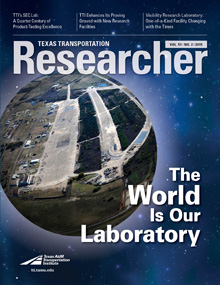In 2009, when the Texas A&M Transportation Institute (TTI) added a Visibility Research Laboratory (VRL) to its collection of world-class research facilities, TTI Senior Research Engineer Paul Carlson had a vision for what the lab could accomplish.
“Before the lab opened, when we needed to take controlled photometric measurements in order to tie those into human performance, we would do it outside at Texas A&M University’s Riverside Campus between midnight and 4 a.m.,” says Carlson, head of TTI’s Operations and Design Division. “Obviously these weren’t ideal conditions since testing equipment gets exposed to the elements or the weather might not cooperate. We’re able to conduct more specialized photometric testing with specialized equipment unavailable in the public domain elsewhere in the country, so far as I know.”

The laboratory is located in TTI’s State Headquarters and Research Building and features a 125-foot-long corridor used to test technologies designed to provide nighttime visibility for highway drivers and other road users. The testing started almost exclusively with retroreflective technologies, but now the VRL is testing lighting technologies and other more recent technologies being considered for the transportation industry.
For the last 50 years, TTI researchers have conducted full-scale, closed-course nighttime driving studies at the Riverside Campus. The outdoor facility allows for static and dynamic visibility and human factors research at speeds up to 70 mph. The VRL complements this full-scale testing facility.

The VRL allows researchers to evaluate existing models related to photometric measurements and standards related to retroreflectivity and lighting. With the capabilities of the VRL, research staff can take existing human factors data related to retroreflective materials collected over the years and compare them to how new materials perform. This allows researchers to more efficiently decide what new materials need to be evaluated in human factors studies. The staff has been able to develop new photometric models related to overhead guide signs with respect to different types of lighting and retroreflective materials using data collected at the Riverside Campus and evaluated in the VRL.
Carlson and TTI Associate Research Engineer Adam Pike developed American Society for Testing and Materials E-2832 — an improved continuous wetting test method for pavement marking measurements with handheld pavement marking retroreflectometers — using the VRL. During the development of this new method, they designed and tested a portable rain simulator that is becoming an industry standard. This work has helped TTI develop a unique platform in the VRL that Pike and Carlson will use to continue expanding the state of the practice with respect to wet nighttime measurements of pavement markings.
“The lab gives us the ability to test some of our field equipment in a controlled environment to make sure everything is operating properly before being tested in the field,” says Pike. “And because it’s indoors, we don’t have to wait for good weather.”
Since the lab opened, researchers have introduced new testing and measurement equipment, which has increased the scope and types of projects TTI conducts. One recently acquired piece of testing equipment is a remote-sensing technology using light detection and ranging that can sense physical highway infrastructure using 360-degree lasers. The researchers are analyzing the reflected light to determine if it can be used to assess the condition (retroreflectivity) of pavement markings and other retroreflective devices. The equipment will undergo testing in the lab before being used in the field and will be used in a Texas Department of Transportation–sponsored project.
“When the lab first opened, we were doing a lot of quality assurance/quality control tasks, but as we’ve evolved, we’re working more with private industry and public agencies to evaluate and perform research and development for new products,” Carlson explains. “LED technologies have also advanced in the last five years, and we’ve had to adapt to keep up with those changes.”
The Federal Aviation Administration is sponsoring a current project to develop a pavement marking inspection system using a smartphone. The photometric range in the VRL allows researchers to examine the effectiveness of runway pavement markings by simulating different pilot vantage points depending on the type of aircraft they might be flying.
Another ongoing project is testing the photoluminescence of bike lanes coated with skid-resistant material. According to Carlson, the visibility properties of bike lanes are reduced when the lanes are coated with this type of material. The researchers hope to find a happy medium of sorts with skid-resistant bike lanes that also meet visibility standards at night.
Researchers are also looking forward to the future by working on advanced pavement marking systems for autonomous vehicles. Autonomous vehicles use pavement marking detection systems to assist vehicles with maintaining their appropriate position on a roadway. Recently, TTI evaluated several different types of pavement markings under wet and dry nighttime conditions to assess whether specific pavement marking properties can improve pavement marking detection by autonomous vehicles. They included nighttime glare conditions and different pavement types.
“This lab has created research opportunities that we may have otherwise not had,” acknowledges Carlson. “It’s been a great asset for our sponsors and the Institute.”
